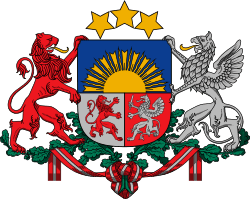Sun (heraldry)


A representation of the sun is used as a heraldic charge. The most usual form, often called sun in splendour or in his glory, consists of a round disc with the features of a human face, surrounded by twelve or sixteen rays, alternating wavy and straight.[1][2] The alternating straight and wavy rays are often said to represent the light and heat of the sun respectively.[3]
It is a common charge in the heraldry of many countries; e.g. the bearings of Armstrong, Canada, and the arms of Banbury Town Council, England.
It often appears as a rising sun as in the arms of East Devon District Council, England, and as a demi sun as in the coat of Aitchison, Canada.
It was used as a badge by Edward II of England, and was later adopted by Edward IV following the appearance of a parhelion or "sun dog" before his victory at the Battle of Mortimer's Cross in 1461.[2][4] It also had significance in alchemy, and may be a symbol of the Roman deity Sol Invictus (Unconquered Sun).[5]
The Sun of May shown on the national flags of Uruguay and Argentina is identical in form to the "Sun in Splendour".
Examples
In splendour
-
 Arms of Amelot family
Arms of Amelot family -
 Three Stars and a Sun in the heraldry of the Philippines
Three Stars and a Sun in the heraldry of the Philippines -

Arms of Arraincourt -
.svg.png)
Arms of Auzeville-Tolosane -
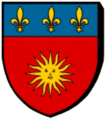
Arms of Basse-Terre -
.svg.png)
Arms of Bassurels -

Arms of Creisset -

Arms of Cuba (Portugal) -
.svg.png)
Arms of Dole (Jura) -

Arms of Ennetbürgen -
.svg.png)
Arms of Fontaines-Saint-Martin -
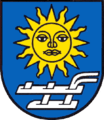
Arms of Känerkinden -

Arms of Loukov -

Arms of El Soleràs -
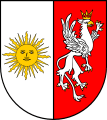
Arms of Tarnopol voivodship -
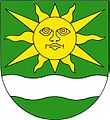
Arms of Vědomice -

Arms of Věžky
Székely Land
Other forms
-

Arms of Archena -

Arms of Arosa -
.svg.png)
Arms of Barbâtre -
.svg.png)
Arms of La Baule-Escoublac -

Arms of Beriáin -
.svg.png)
Flag of the Colorado Party, in the Uruguayan Civil War -

Arms of Dobel -

Arms of Écija -

Arms of the Diocese of Gothenburg -

Arms of Galar -

Naval Ensign of Japan -

Arms of Jēkabpils District -

Arms of Mende -

Arms of Naantalin maalaiskunta -

Arms of Sankt Gilgen
See also
| Wikimedia Commons has media related to Sun in heraldry. |
References
- ↑ James Parker, A glossary of terms used in heraldry. Accessed 13 December 2009
- ↑ 2.0 2.1 Dictionary of Vexillology. Accessed 13 December 2009
- ↑ Fox-Davies, A.C., (1969) A complete guide to heraldry. Aylesbury: Thomas Nelson and Sons. p. 222.
- ↑ Encyclopaedia Britannica: Edward IV and the Alchemists. Accessed 13 December 2009
- ↑ Banbury Faith Trail. Accessed 13 December 2009





